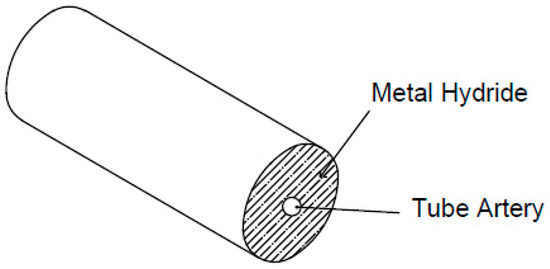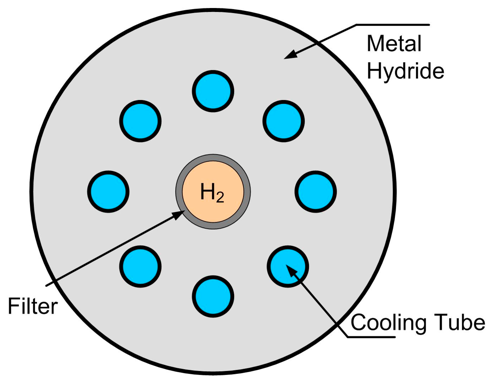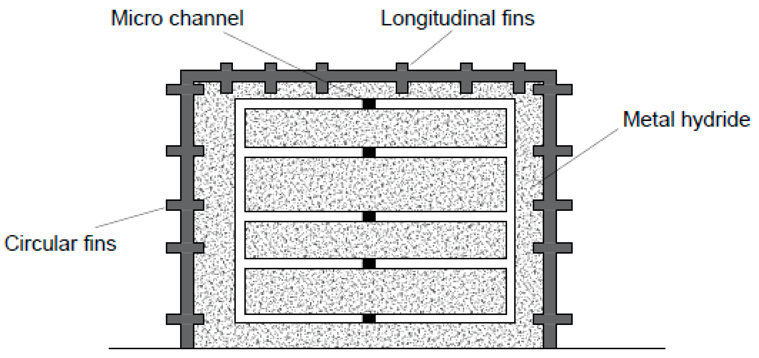
Key Technical Issues of Metal Hydride Reactor Designs for Hydrogen Energy Storage
Many industries use metal hydride reactors for different applications. For instance, heat pumps, gas separation, thermal compressions, hydrogen storage, and others. The metal hydride reactors greatly depend on their performance in their design. Hence, the design of the reactor requires careful study. Metal hydride has a complicated nature and formation/decomposition processes. That is why the metal hydride reactor designs have a series of technical issues. The issues should be adequately considered and addressed to fulfil the demands of a certain application. This article reviews the design issues with representative achievements in detail. It is concluded that integrated considerations of the metal hydride system make an optimized reactor design.
Primary Scheme of Configuration
The metal hydride reactor offers the space where the materials are filled. Or it serves as a compact bed-type container which should facilitate mass and heat exchange of the MH bed too. Many MH reactors are developed, and all these MH reactors have basic configurations that cover three categories based on the geometry of the reaction bed.
Tubular Reactor

The tubular reactor has a central artery that is generally provided for hydrogen flow. Metal hydride materials are filled in the annular space between the wall and the artery. Whereas the external surface of the tube well conducts the heat exchange of the reaction bed with the heat sink/source. Since the early MH applications, tubular reactors have been used in heat pump systems. The design of this application has been improving since its beginning.
The tubular reactor has good sealing as well as bearing pressure. Plus, the units of these tubes are also modular and work independently. Hence, these reactors are relatively easy to scale up by upgrading the units. For small-scale tests, single sibilant reactors are quite suitable. Whereas tube banks or columns can be used for applications with a bigger capacity.
Disc reactor

The disc reactor reaction bed has a flat shape and an aspect ratio that is much smaller than 1. The hydrogen axially flows into and out of the MH reactor in a conventional layout through the screen that covers the MH layer. At the same time, on the other side, heat exchange is carried out. The disc reactor includes a large heat transfer area, introducing fast reaction kinetics for thin beds. But a single disc can only contain a small amount of metal hydride.
The structure, with mass and heat elements on both sides of the disc reactor, makes it technically difficult to extend the capacity through more units. In these reactors, the metal hydride is filled in the disc units. Hydrogen, flowing in these tubes, penetrates through the units. This allows mass transfer with metal hydride in the radial direction. Simultaneously, heat transfer takes place on the external disc unit surfaces. Adjusting the distance and dimension of the disc/annulus units enabled a fast reaction.
Tank or chamber reactor

In a chamber or tank metal hydride reactor, a cube or cylinder chamber of an appropriate size is utilized as the reaction bed. It enables more MH materials to be filled in relative to the before-mentioned reactor types. Hydrogen can freely enter or leave the reactor through the surrounding outer filter or inserted arteries. Generally, the heat exchange of the metal hydride bed is done by some embedded elements. These elements include heat pipes, spiral coils, and ordinary tube bundles.
The recent micro-channel technique showed amazing potential to gain intensive heat transfer within a limited area. Apart from the improvement of heat transfer, this design also offers the benefit that drives the fluid flow for heat transfer by capillary or electro-kinetic force. The most significant characteristic of a tank reactor is its large capacity. Thus, it is recommended to be utilized for applications where more metal hydride materials are required for needed output. But the layout and the number of mass and heat transfer elements must be determined properly as the bed dimensions increase. It is important to meet the standards and needs for good performance.
In Conclusion, observations from Vamsi Kukkapalli’s research review paper of “Thermal Management Techniques in Metal Hydrides for Hydrogen Storage Applications: A Review” the MH reactor technology development is introduced to address the safety issues caused due to storage of hydrogen in pressurized containers. It is determined that with the help of different relevant communities, the MH reactor design has advanced continuously in many factors.
The discrimination of various reactors needs to be clarified, but here, a simple guideline is concluded for choosing a reactor configuration. The tubular reactor is commonly proffered in compressor systems and heat pumps. The chamber or tank reactor is widely used in storage-related equipment. The disc reactor has been extensively limited to kinetic measurement till now. The difficulty in choosing an optimized scheme is somehow solved with the usage of an analytic hierarchy process.
Reference:
Kukkapalli VK, Kim S, Thomas SA. Thermal Management Techniques in Metal Hydrides for Hydrogen Storage Applications: A Review. Energies. 2023; 16(8):3444. https://doi.org/10.3390/en16083444







